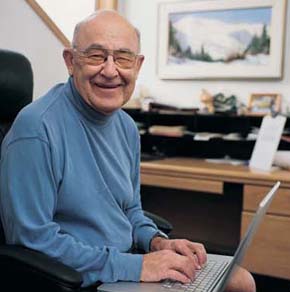 |
 |
| current issue |  |
past issues |  |
send a letter/news |  |
address update |  |
advertise |  |
about us |  |
alumni home |
Features
The Write WayDonald Graves started a revolution just by watching young children as they wrote in school
By Kimberly Swick Slover
 Photo by Lisa Nugent |
A class of second-graders at the Josiah Bartlett Elementary School in Bartlett, N.H., sits on the floor, on beanbags and in chairs, as their teacher, Lucy Swain, reads her story. Swain has begun an experiment in her children's writing instruction: She is writing her own story, and each day, she shares the process, her missteps and small successes, as she struggles to compose her piece. Knowing their teacher is a great animal lover, the children are thrilled when two of her dogs, Oakley and Tucker, appear in the story and talk to each other in goofy dog voices.
When the story ends, the children yell out the names of Swain's other dogs and demand that she put them, and her horses, in the story too. "You could have the dogs rounding up the horses!" suggests one. Swain feigns exasperation. "I could choose to have eight dogs in my story or 19 dogs, but I just want two!" she says. "Writers have to make decisions about their stories. In your stories, you'll have to make your own decisions."
Donald Graves, a UNH professor emeritus of early childhood education and former director of the Writing Laboratory, watches from the back of the room. Accompanying him is a film crew that will assist in producing a DVD series for teachers called "Inside Writing." As the pioneer in literacy education who changed the way that writing is taught across the United States and the English-speaking world, the 74-year-old educator is now leading the revolution he sparked in new directions.
"For years I've recommended that teachers write with their pupils, but very few have done that," Graves explains. "These DVDs will show teachers teaching through their own writing. Teachers need to see how effective it is in instruction."
Swain is a recent convert who has come to see that by writing with her pupils, she can model thought and writing processes and show her children, step by step, how to write.
 Photo by Britt Erlanson |
After class, Graves interviews Swain, cameras rolling, about how her writing has changed the way she teaches. He sits near her, listening intently as she speaks. "I used to tell pupils to think of a beginning, middle and ending before they started writing a story, but now I see it doesn't really work that way," she says.
Following his retirement from UNH in 1992, Graves and his wife of 50 years, Betty, moved to a mountaintop home overlooking New Hampshire's Mt. Washington Valley. On a late October day, as he chats in his second-floor study, gray scudding clouds descend from the peaks of North and South Doublehead, two mountains that loom outside his window. Within minutes, heavy raindrops patter on the skylight. From his perch on Green Mountain, Graves often witnesses storms in the making.
More than two decades ago, Graves created his own storm with the publication of Writing: Teachers & Children at Work, based on a two-year study of elementary school children in Atkinson, N.H. His research revealed writing as a natural human need for self-expression and a way to develop and hone critical thinking skills. "Children want to write," Graves begins in the first chapter. "They want to write the first day they attend school. This is no accident. Before they went to school, they marked up walls, pavements, newspapers with crayons, chalk, pens or pencils... anything that makes a mark. The child's marks say, 'I am.'"
Page: 1 2 3 45 Next >Easy to print version
blog comments powered by Disqus

